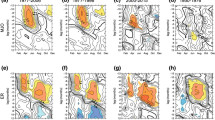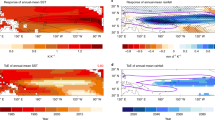Abstract
The significant inter-decadal change in potential predictability of the East Asian summer monsoon (EASM) has been investigated using the signal-to-noise ratio method. The relatively low potential predictability appears from the early 1950s through the late 1970s and during the early 2000s, whereas the potential predictability is relatively high from the early 1980s through the late 1990s. The inter-decadal change in potential predictability of the EASM can be attributed mainly to variations in the external signal of the EASM. The latter is mostly caused by the El Niño–Southern Oscillation (ENSO) inter-decadal variability. As a major external signal of the EASM, the ENSO inter-decadal variability experiences phase transitions from negative to positive phases in the late 1970s, and to negative phases in the late 1990s. Additionally, ENSO is generally strong (weak) during a positive (negative) phase of the ENSO inter-decadal variability. The strong ENSO is expected to have a greater influence on the EASM, and vice versa. As a result, the potential predictability of the EASM tends to be high (low) during a positive (negative) phase of the ENSO inter-decadal variability. Furthermore, a suite of Pacific Pacemaker experiments suggests that the ENSO inter-decadal variability may be a key pacemaker of the inter-decadal change in potential predictability of the EASM.












Similar content being viewed by others
References
Bretherton CS, Widmann M, Dymnikov VP, Wallace JM, Bladé I (1999) The effective number of spatial degrees of freedom of a time-varying field. J Clim 12:1990–2009
Cash BA, Rodó X, Kinter JL III, Yunus M (2010) Disentangling the impact of ENSO and Indian Ocean variability on the regional climate of Bangladesh: implications for cholera risk. J Clim 23:2817–2831
Chan JCL, Zhou W (2005) PDO, ENSO and the early summer monsoon rainfall over south China. Geophys Res Lett 32:93–114
Chen T-JG, Chang C-P (1980) The structure and vorticity budget of an early summer monsoon trough (Mei-Yu) over southeastern China and Japan. Mon Weather Rev 108:942–953
Compo GP, Whitaker JS, Sardeshmukh PD, Matsui N, Allan RJ, Yin X, Gleason BE, Vose RS, Rutledge G, Bessemoulin P (2011) The twentieth century reanalysis project. Q J Roy Meteor Soc 137:1–28
Ding R, Ha KJ, Li J (2010) Inter-decadal shift in the relationship between the East Asian summer monsoon and the tropical Indian Ocean. Clim Dynam 34:1059–1071
Ding R, Li J, Tseng YH, Sun C, Guo Y (2015) The Victoria mode in the North Pacific linking extratropical sea level pressure variations to ENSO. J Geophys Res 120:27–45
Ding Y (1992) Summer monsoon rainfalls in China. J Meteorol Soc Jpn 70:373–396
Ding Y, Sun Y, Wang Z, Zhu Y, Song Y (2009) Inter-decadal variation of the summer precipitation in China and its association with decreasing Asian summer monsoon part II: possible causes. Int J Climatol 29:1926–1944
Ding Y, Wang Z, Sun Y (2008) Inter-decadal variation of the summer precipitation in East China and its association with decreasing Asian summer monsoon. Part I: observed evidences. Int J Climatol 28:1139–1161
Duan A, Wu G (2008) Weakening trend in the atmospheric heat source over the Tibetan Plateau during recent decades. Part I: observations. J Clim 21:3149–3164
Gadgil S, Rajeevan M, Nanjundiah R (2005) Monsoon prediction—why yet another failure. Curr Sci 88:1389–1400
Gong DY, Ho CH (2002) Shift in the summer rainfall over the Yangtze River valley in the late 1970s. Geophys Res Lett 29(10):78-1–78-4. https://doi.org/10.1029/2001GL014523
Goswami B (2004) Inter-decadal change in potential predictability of the Indian summer monsoon. Geophys Res Lett 31(16):371–375
Guo QY (1983) The summer monsoon intensity index in East Asia and its variation. Acta Geograph Sin 38:207–217
Huang G, Yan Z (1999) The East Asian summer monsoon circulation anomaly index and its interannual variations. Chin Sci Bull 44:1325–1329
Huang R, Chen J, Huang G (2007) Characteristics and variations of the East Asian monsoon system and its impacts on climate disasters in China. Adv Atmos Sci 24:993–1023
Huang R, Liang Y, Song L (1992) Variability of summer droughts and floods in China during recent 40 years and primary investigation of its causes. LASG special research Collections: 14–28
Jones RH (1975) Estimating the variance of time averages. J Appl Meteorol 14:159–163
Ju JH, Qian C, Cao J (2005) The intraseasonal oscillation of East Asian summer monsoon. Chin J Atmos Sci 29:187–194
Kachi M, Nitta T (1997) Decadal variations of the global atmosphere-ocean system. J Meteorol Soc Jpn 75:657–675
Kalnay E, Kanamitsu M, Kistler R, Collins W, Deaven D, Gandin L, Iredell M, Saha S, White G, Woollen J (1996) The NCEP/NCAR 40-year reanalysis project. B Am Meteorol Soc 77:437–471
Li J, Chou J (1997) Existence of the atmosphere attractor. Sci China Ser D 40:215–220
Li J, Zeng Q (2002) A unified monsoon index. Geophys Res Lett 29:115–111–115-114
Liang J, Wu S, You J (1999) The research on variations of onset time of the SCS summer monsoon and its intensity. J Trop Meteorol 2:97–105 (in Chinese)
Liu Y, Huang G, Huang R (2011) Inter-decadal variability of summer rainfall in Eastern China detected by the Lepage test. Theor Appl Climatol 106:481–488
Lorenz EN (1963) Deterministic nonperiodic flow. J Atmos Sci 20:130–141
Lorenz EN (1965) A study of the predictability of a 28-variable atmospheric model. Tellus 17:321–333
Madden RA (1976) Estimates of the natural variability of time-averaged sea-level pressure. Mon Weather Rev 104:942–952
Menon S, Hansen J, Nazarenko L, Luo Y (2002) Climate effects of black carbon aerosols in China and India. Science 297:2250–2253
Nitta T, Hu ZZ (1996) Summer climate variability in China and its association with 500 hPa height and tropical convection. J Meteorol Soc Jpn 74:425–445
Rowell DP (1996) Assessing potential seasonal predictability with an ensemble of multidecadal GCM simulations. J Clim 11:109–120
Rowell DP, Folland CK, Maskell K, Ward MN (2010) Variability of summer rainfall over tropical North Africa (1906–92): observations and modelling. Q J Roy Meteor Soc 121:669–704
Shi H, Zhou T, Wan H, Wang B, Yu R (2008) SMIP2 experiment-based analysis on the simulation and potential predictability of Asian summer monsoon. Chin J Atmos Sci 32:36 (in Chinese)
Shukla J, Gutzler D (1983) Interannual variability and predictability of 500 mb geopotential heights over the Northern Hemisphere. Mon Weather Rev 111:1273–1279
Smith TM, Reynolds RW, Peterson TC, Lawrimore J (2008) Improvements to NOAA’s historical merged land–ocean surface temperature analysis (1880–2006). J Clim 21:2283–2296
Song F, Zhou T (2015) The crucial role of internal variability in modulating the decadal variation of the East Asian summer monsoon–ENSO relationship during the twentieth century. J Clim 28:7093–7107
Sui CH, Chung PH, Li T (2007) Interannual and inter-decadal variability of the summertime western North Pacific subtropical high. Geophys Res Lett 34:93–104
Tao SY, Chen LX (1987) A review of recent research on the East Asian summer monsoon in China. In: CP Chang and TN Krishnamurti (Eds) Monsoon meteorology, Oxford University Press, England, pp 60–92
Trenberth KE (1984) Some effects of finite sample size and persistence on meteorological statistics. Part II: potential predictability. Mon Weather Rev 112:2369–2379
Trenberth KE (1985) Potential predictability of geopotential heights over the southern hemisphere. Mon Weather Rev 113:54–64
Wang B, Bao Q, Hoskins B, Wu G, Liu Y (2008a) Tibetan Plateau warming and precipitation changes in East Asia. Geophys Res Lett 35(14):63–72
Wang B, Fan Z (1999) Choice of South Asian summer monsoon indices. B Am Meteorol Soc 80:629–638
Wang B, Wu R, Fu X (2000) Pacific–East Asian teleconnection: how does ENSO affect east Asian climate? J Clim 13:1517–1536
Wang B, Wu Z, Li J, Liu J, Chang CP, Ding Y, Wu G (2008b) How to measure the strength of the East Asian summer monsoon. J Clim 21:4449–4463
Wang B, Yang J, Zhou T, Wang B (2008c) Inter-decadal changes in the major modes of Asian–Australian monsoon variability: strengthening relationship with ENSO since the late 1970s. J Clim 21:1771–1789
Webster PJ, Yang S (1992) Monsoon and Enso: selectively interactive systems. Q J Roy Meteor Soc 118:877–926
Wu B, Li T, Zhou T (2010a) Relative contributions of the Indian Ocean and local SST anomalies to the maintenance of the western North Pacific anomalous anticyclone during the El Niño decaying summer. J Clim 23:2974–2986
Wu B, Zhang R, Wang B (2009a) On the association between spring Arctic sea ice concentration and Chinese summer rainfall: a further study. Adv Atmos Sci 26:666–678
Wu G, Liu Y, Dong B, Liang X, Duan A, Bao Q, Yu J (2012a) Revisiting Asian monsoon formation and change associated with Tibetan Plateau forcing: I. Formation. Clim Dynam 39:1183–1195
Wu G, Liu Y, Dong B, Liang X, Duan A, Bao Q, Yu J (2012b) Revisiting Asian monsoon formation and change associated with Tibetan Plateau forcing: II. Change. Clim Dynam 39:1183–1195
Wu RG, Wen ZP, Song Y, Li YQ (2010b) An inter-decadal change in Southern China summer rainfall around 1992/93. J Clim 23:2389–2403
Wu Z, Li J, Jiang Z, He J, Zhu X (2012c) Possible effects of the North Atlantic oscillation on the strengthening relationship between the East Asian summer monsoon and ENSO. Int J Climatol 32:794–800
Wu Z, Wang B, Li J, Jin FF (2009b) An empirical seasonal prediction model of the East Asian summer monsoon using ENSO and NAO. J Geophys Res 114:85–86
Wu Z, Yu L (2016) Seasonal prediction of the East Asian summer monsoon with a partial-least square model. Clim Dynam 46:3067–3078
Xie SP, Kosaka Y, Du Y, Hu K, Chowdary JS, Huang G (2016) Indo-western Pacific Ocean capacitor and coherent climate anomalies in post-ENSO summer: a review. Adv Atmos Sci 33:411–432
Xu Q (2001) Abrupt change of the mid-summer climate in central east China by the influence of atmospheric pollution. Atmos Environ 35:5029–5040
Xue F (2001) Interannual to inter-decadal variation of east asian summer monsoon and its association with the global atmospheric circulation and sea surface temperature. Adv Atmos Sci 18:567–575. https://doi.org/10.1007/s00376-001-0045-x
Yang J, Liu Q, Xie SP, Liu Z, Wu L (2007) Impact of the Indian Ocean SST basin mode on the Asian summer monsoon. Geophys Res Lett 34(2):155–164
Zhang L, Sielmann F, Fraedrich K, Zhu X, Zhi X (2015) Variability of winter extreme precipitation in Southeast China: contributions of SST anomalies. Clim Dynam 45:2557–2570
Zhang Q, Tao S, Chen L (2003) The interannual variability of East Asian summer monsoon indices and its association with the pattern of general circulation over East Asia. Acta Meteorol Sin 61:559–568
Zhang W, Li H, Stuecker MF, Jin FF, Turner AG (2016) A new understanding of El Niño’s impact over East Asia: dominance of the ENSO combination mode. J Clim 29:4347–4359
Zhao Y, Xu X, Zhao T, Xu H, Mao F, Sun H, Wang Y (2016) Extreme precipitation events in East China and associated moisture transport pathways. Sci China Earth Sci 59:1854–1872
Zheng X, Nakamura H, Renwick JA (2000) Potential predictability of seasonal means based on monthly time series of meteorological variables. J Clim 13:2591–2604
Zhou T, Gong D, Li J, Li B (2009) Detecting and understanding the multi-decadal variability of the east Asian summer monsoon—recent progress and state of affairs. Meteorol Z 18:455–467
Zhu Y (2003) Relationships between Pacific decadal oscillation (PDO) and climate variabilities in China. Acta Meteorol Sin 61:641–654
Acknowledgments
We acknowledge the helpful suggestions from the anonymous reviewers. We thank NCAR CESM for providing the Pacemaker experiment data (http://www.cesm.ucar.edu/experiments/). The reanalysis data including atmospheric fields was available at https://www.esrl.noaa.gov/psd/data/gridded/. The ENSO episodes come from the Climate Prediction Center (http://www.cpc.ncep.noaa.gov). We also thank the ERSSTv3b data that is obtained from https://www.esrl.noaa.gov/psd/data/gridded/data.noaa.ersst.v3.html.
Author information
Authors and Affiliations
Contributions
This work is jointly supported by the National Natural Science Foundation of China for Excellent Young Scholars (41522502), the National Program on Global Change and Air-Sea Interaction (GASI-IPOVAI-03; GASI-IPOVAI-06), and the National Key Technology Research and Development Program of the Ministry of Science and Technology of China (2015BAC03B07).
Corresponding authors
Rights and permissions
About this article
Cite this article
Li, J., Ding, R., Wu, Z. et al. Inter-decadal change in potential predictability of the East Asian summer monsoon. Theor Appl Climatol 136, 403–415 (2019). https://doi.org/10.1007/s00704-018-2482-9
Received:
Accepted:
Published:
Issue Date:
DOI: https://doi.org/10.1007/s00704-018-2482-9




